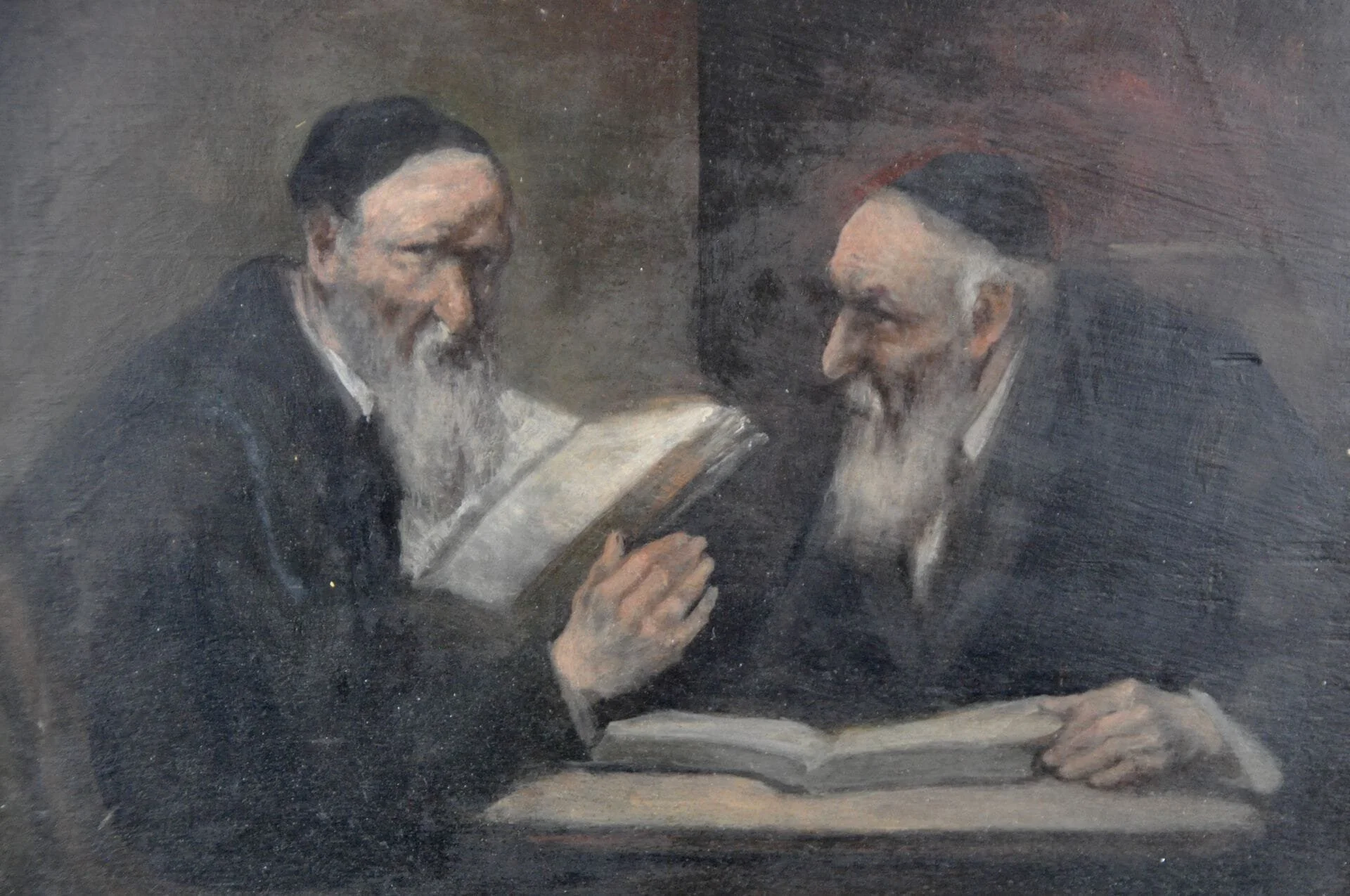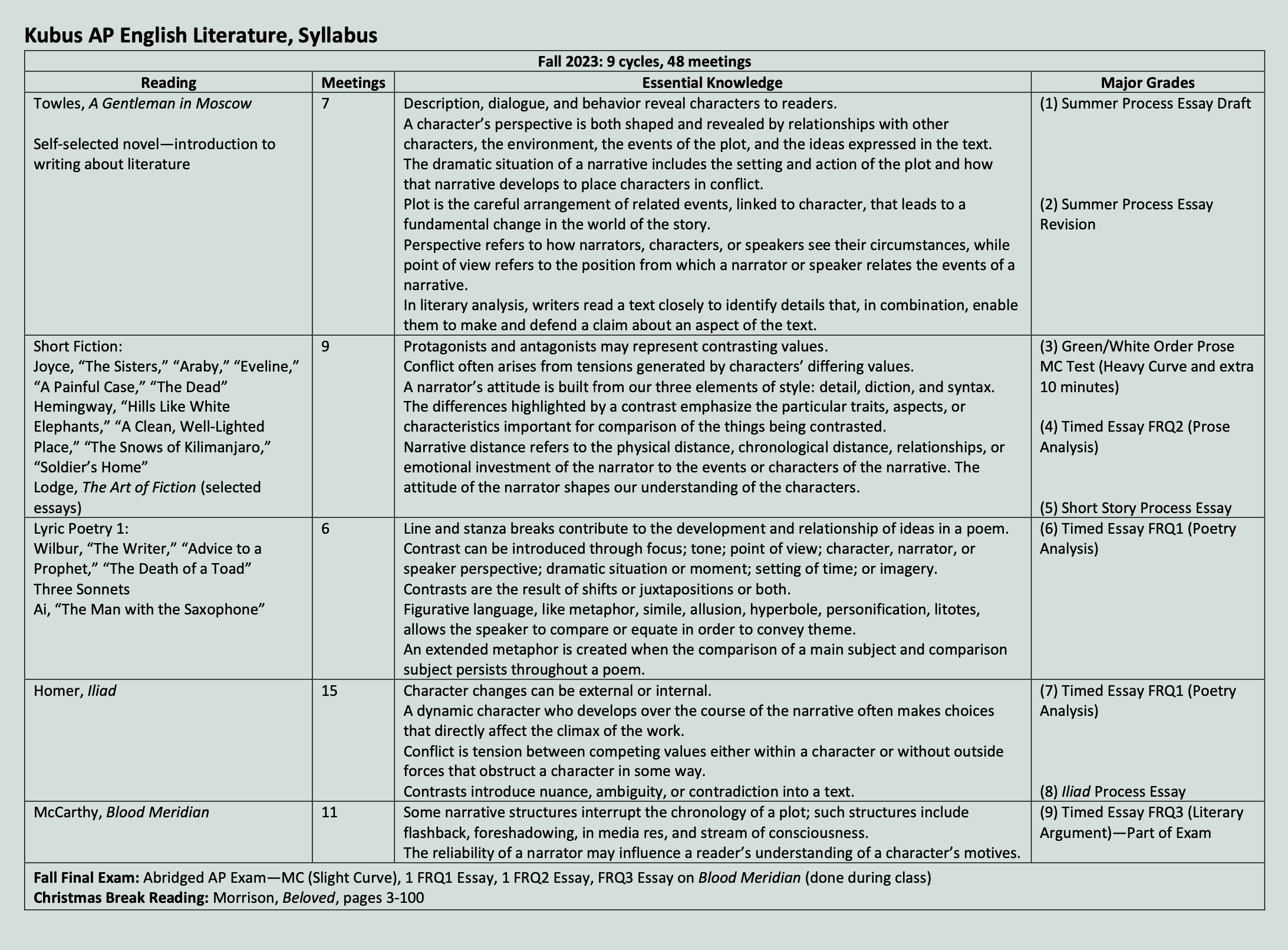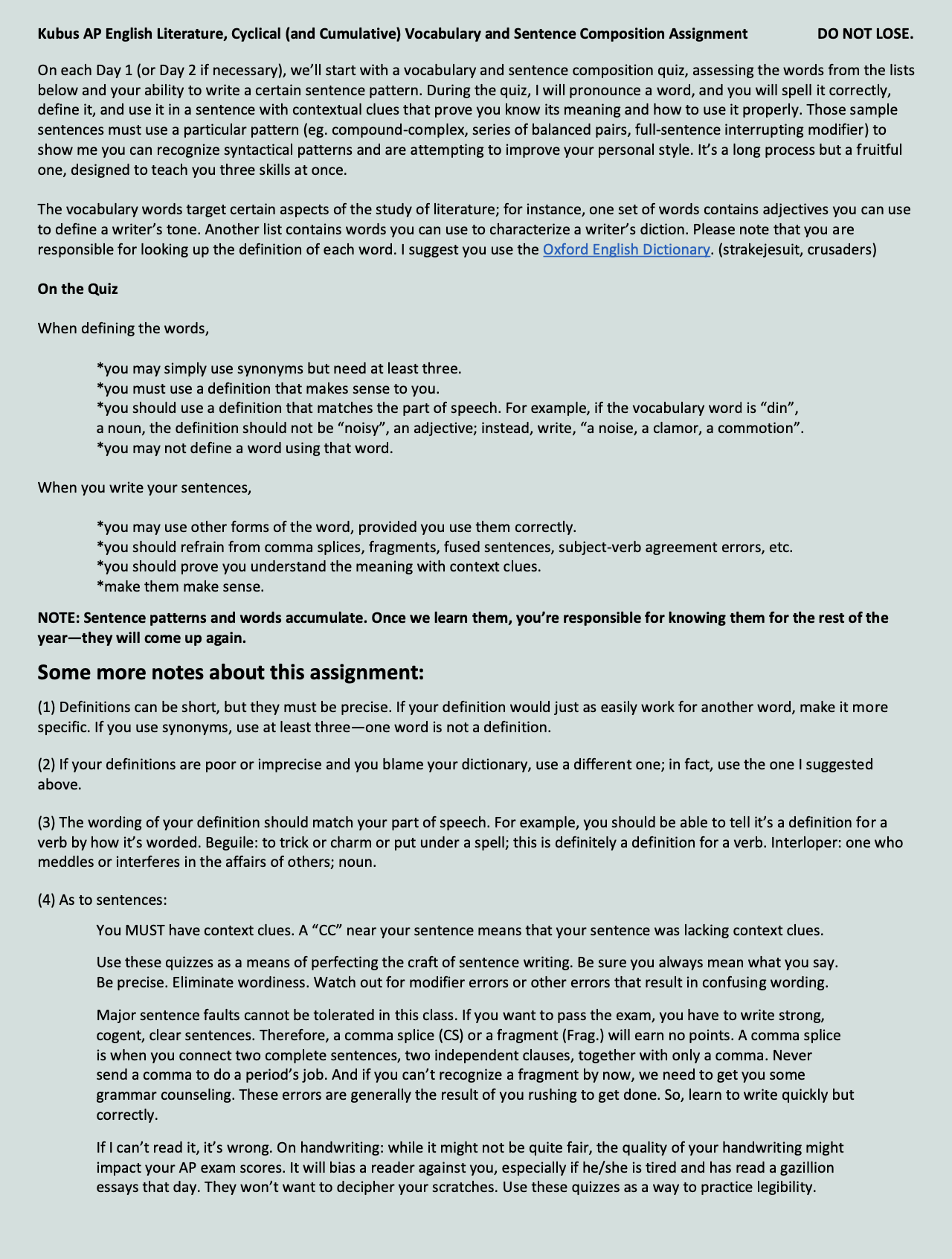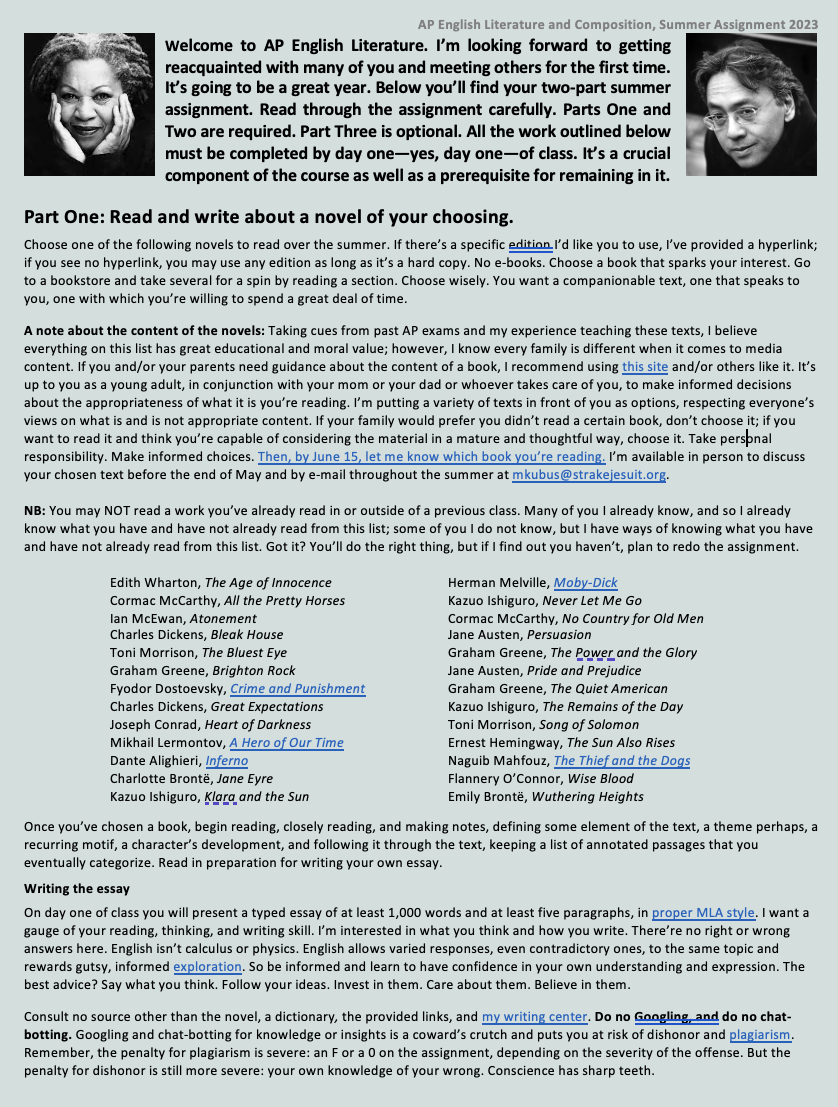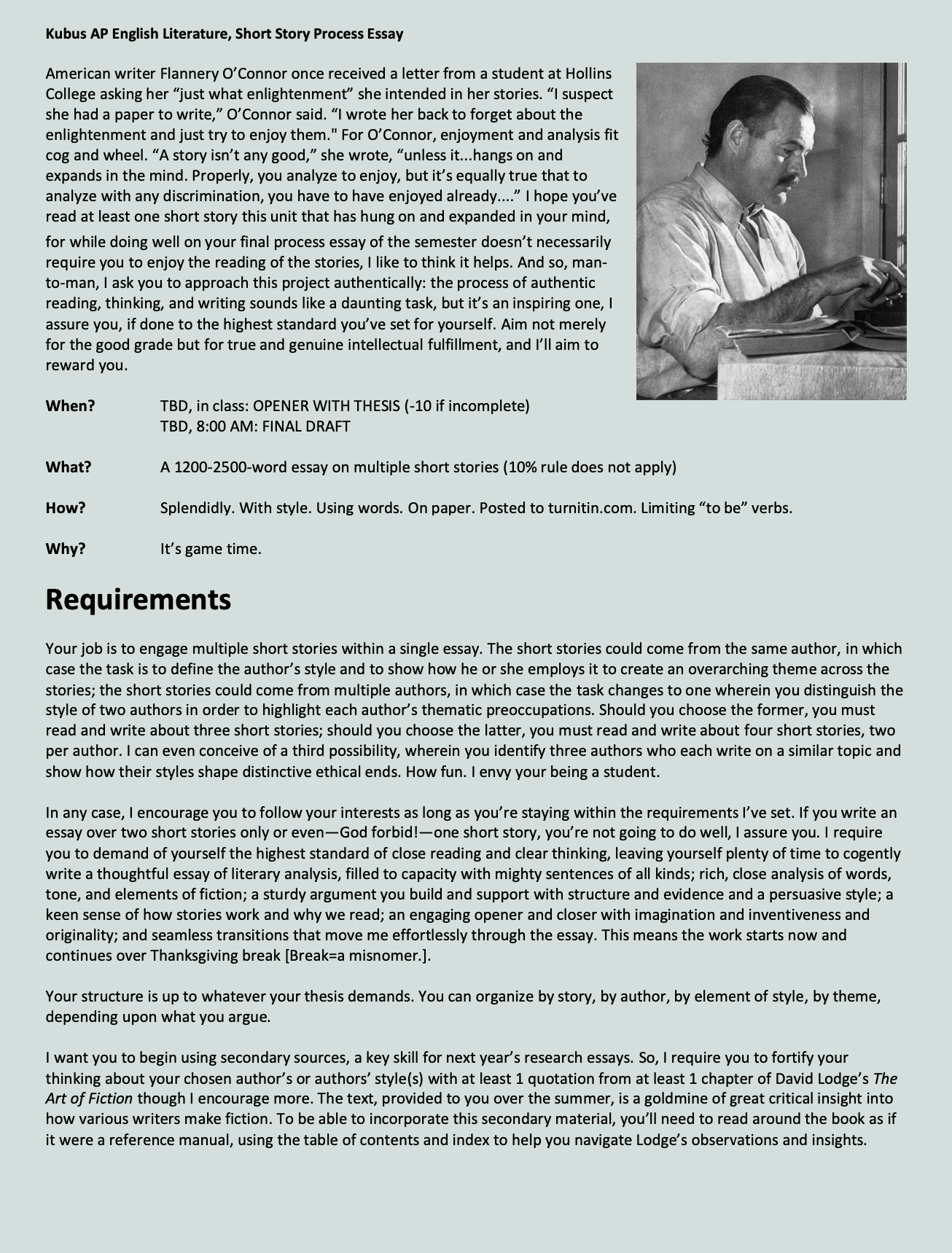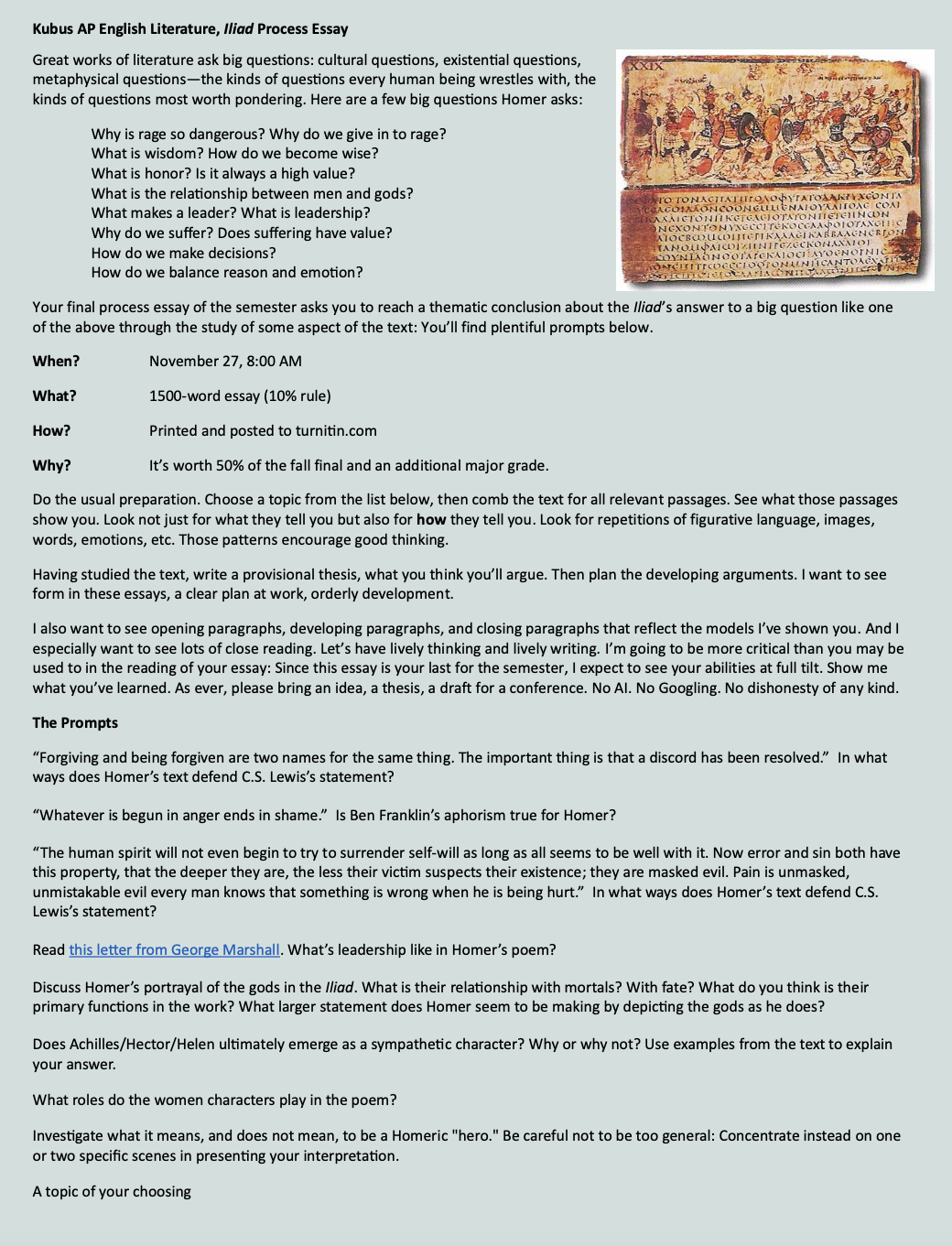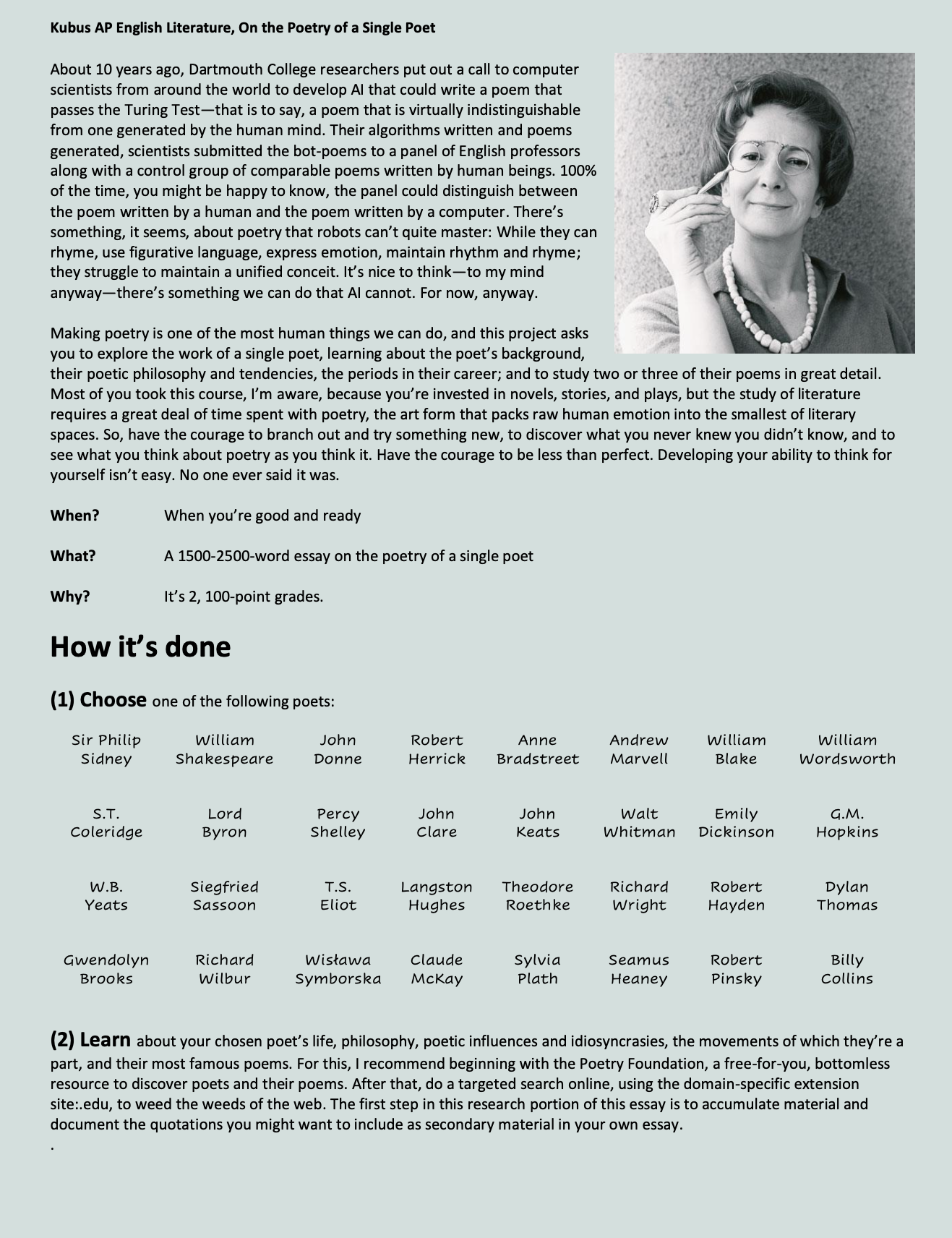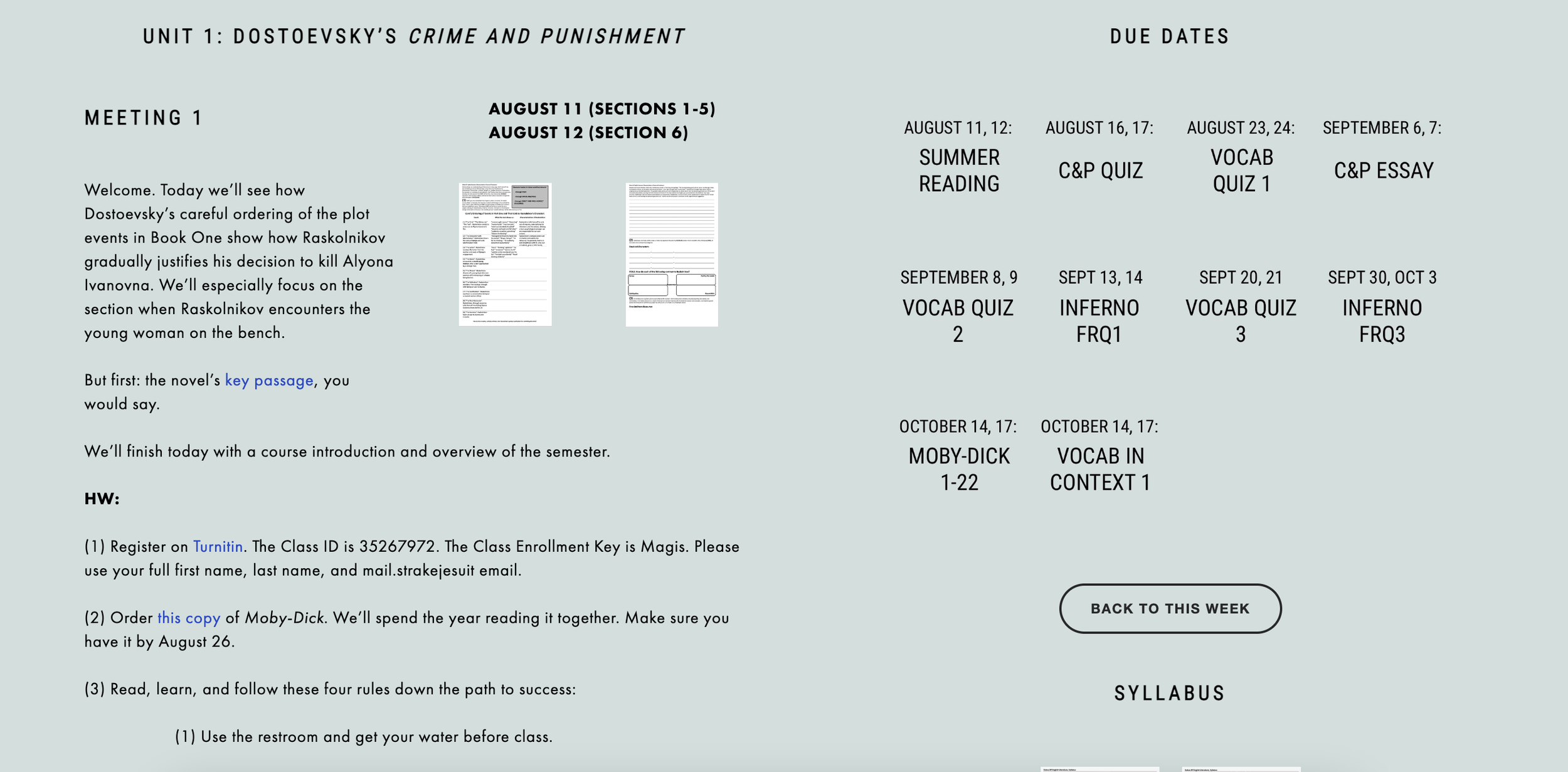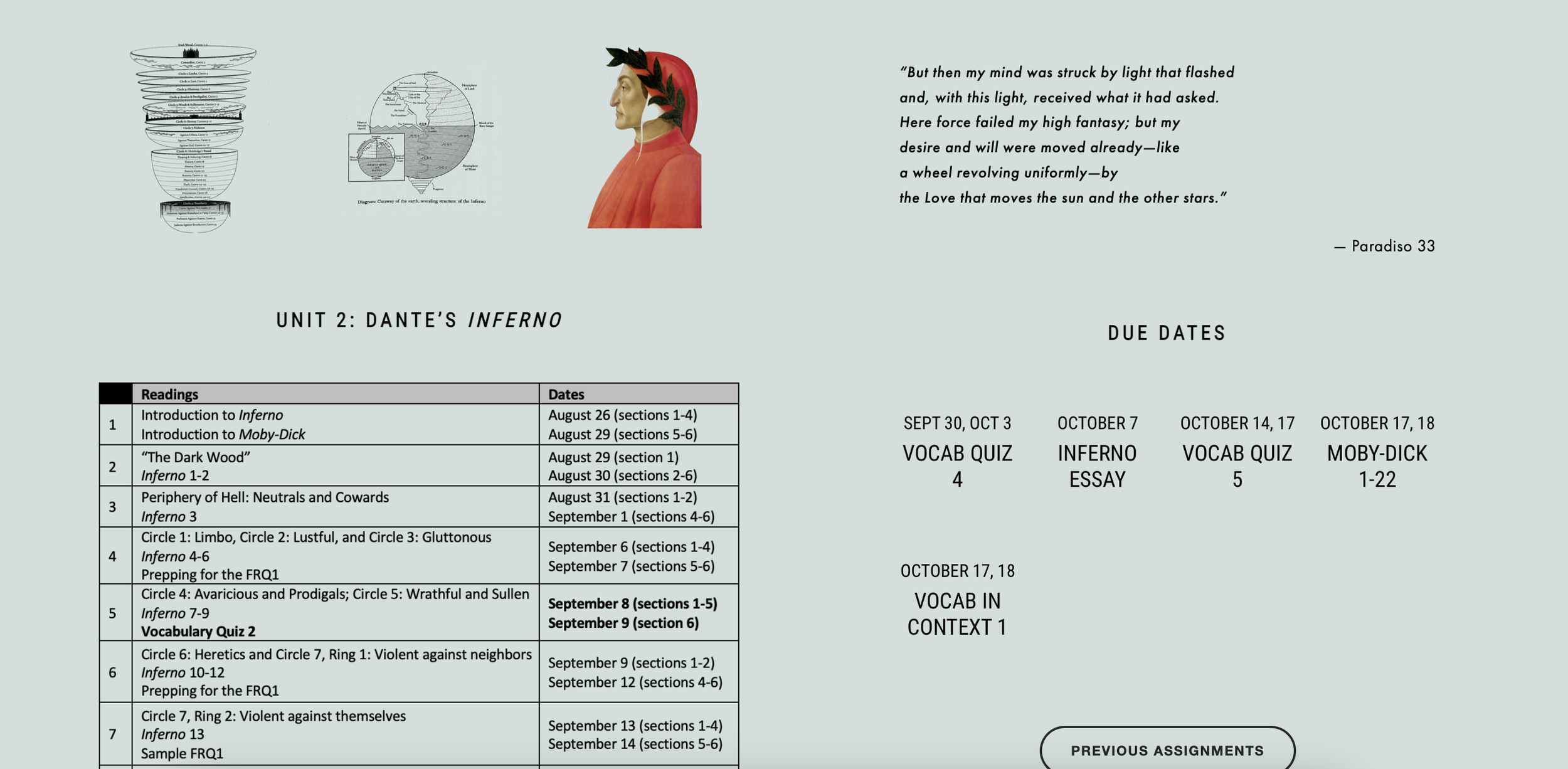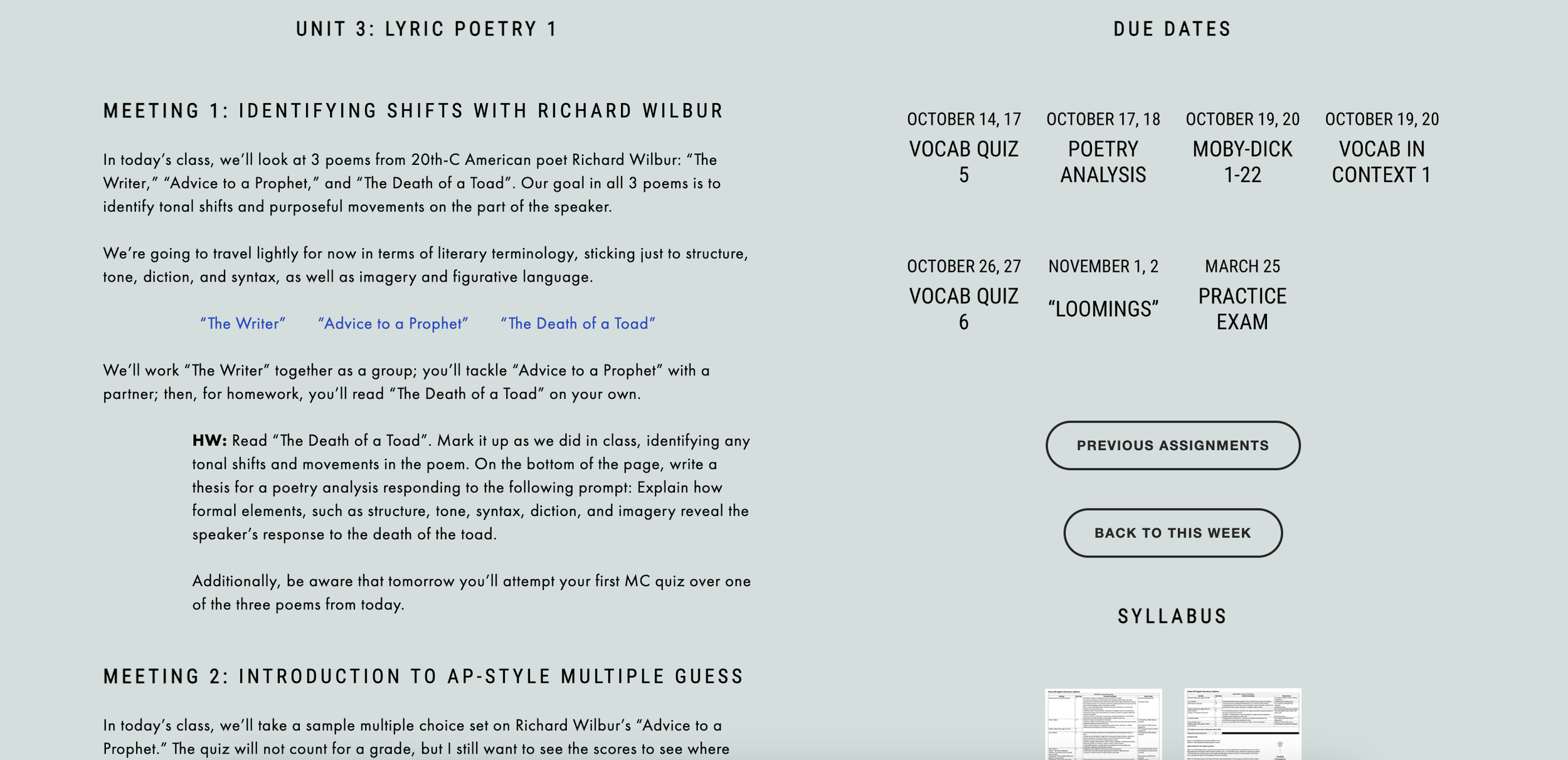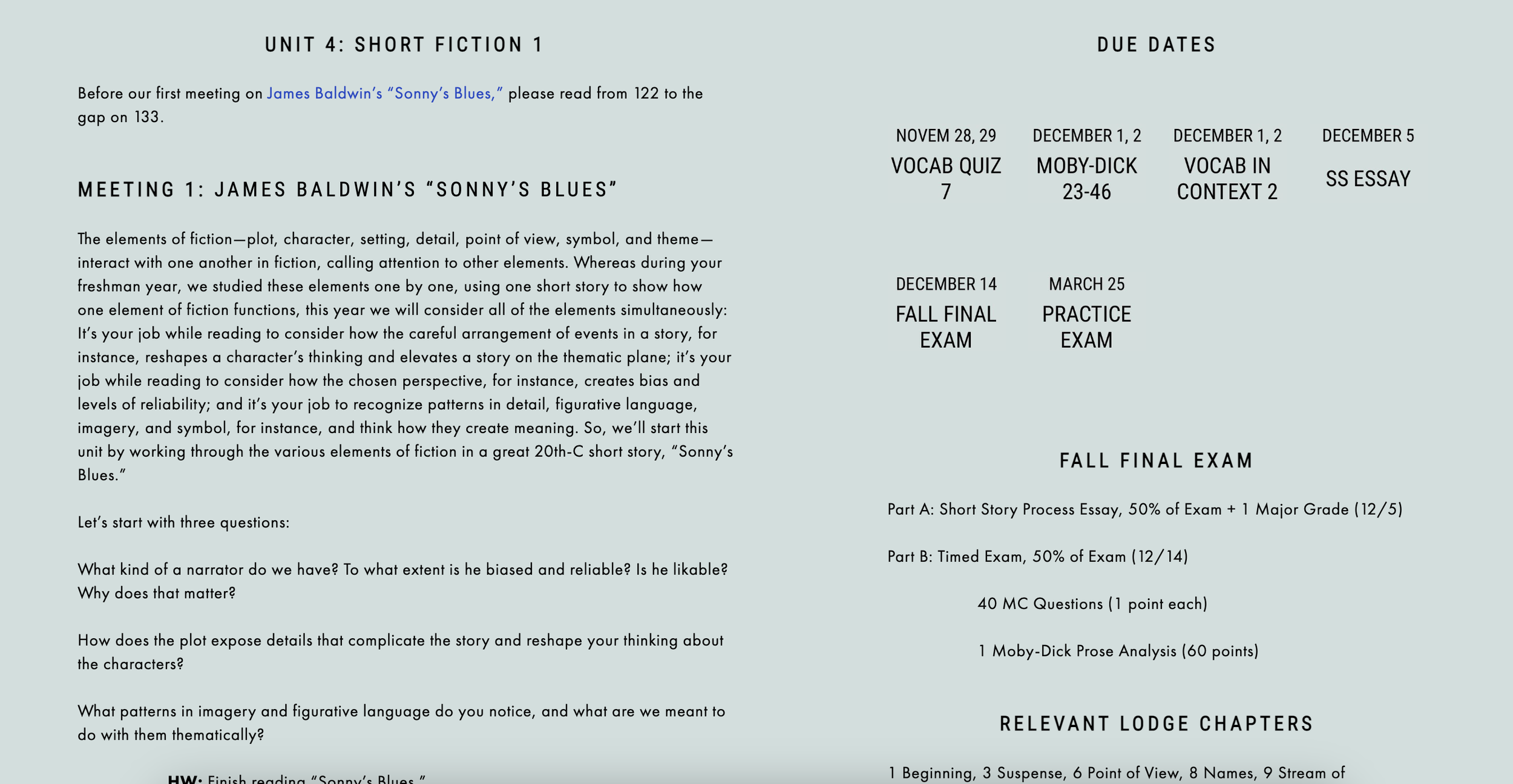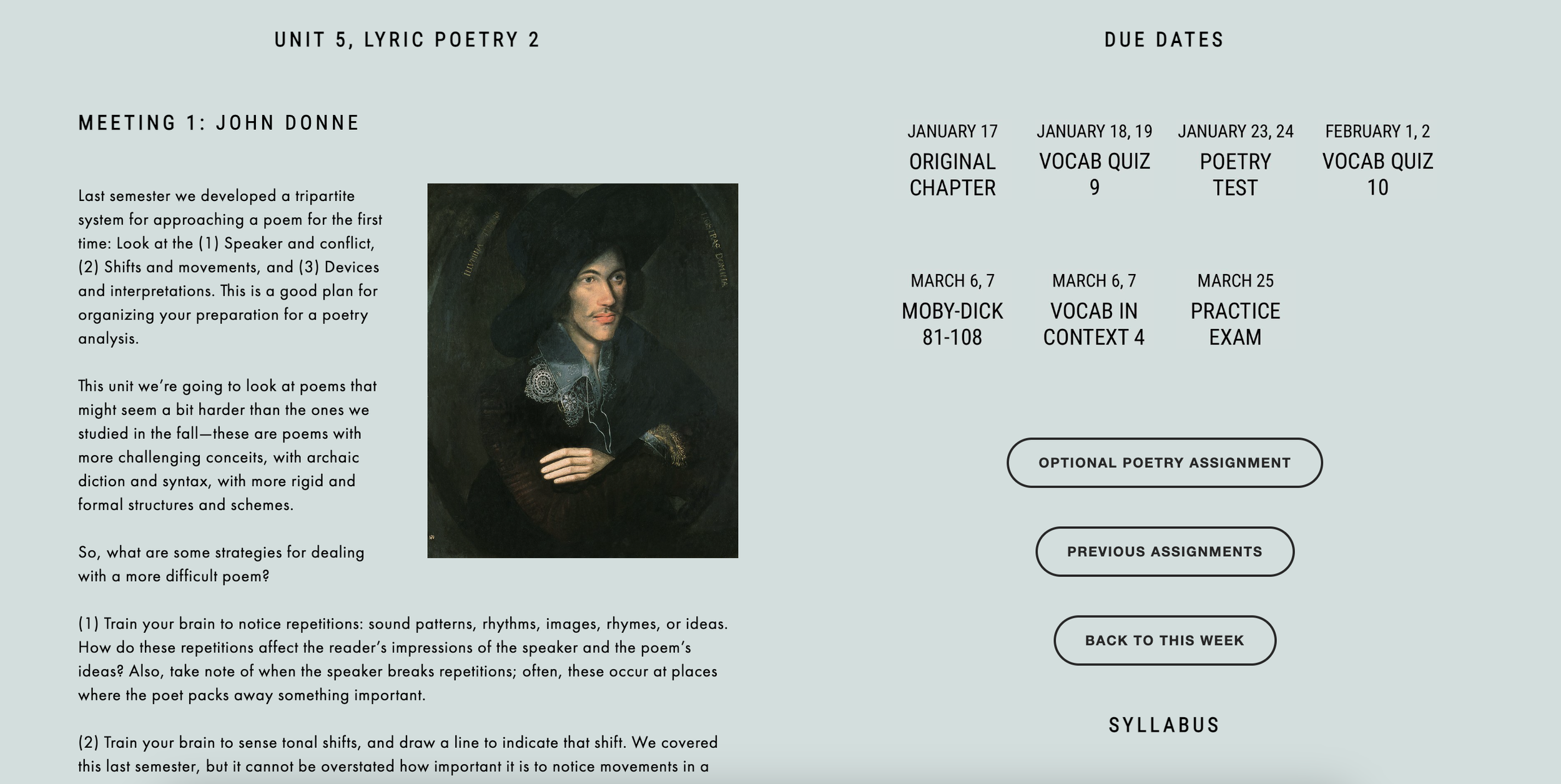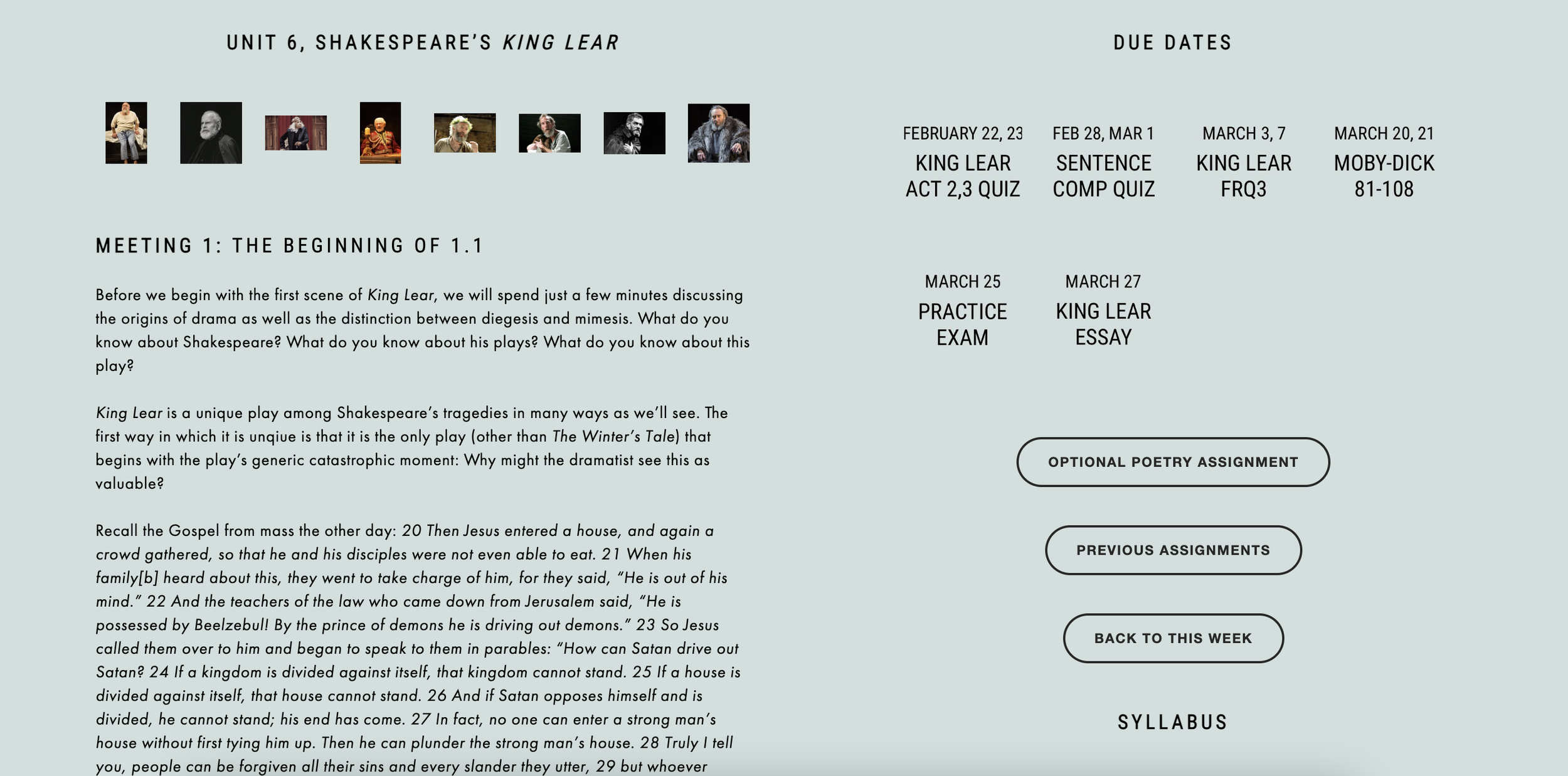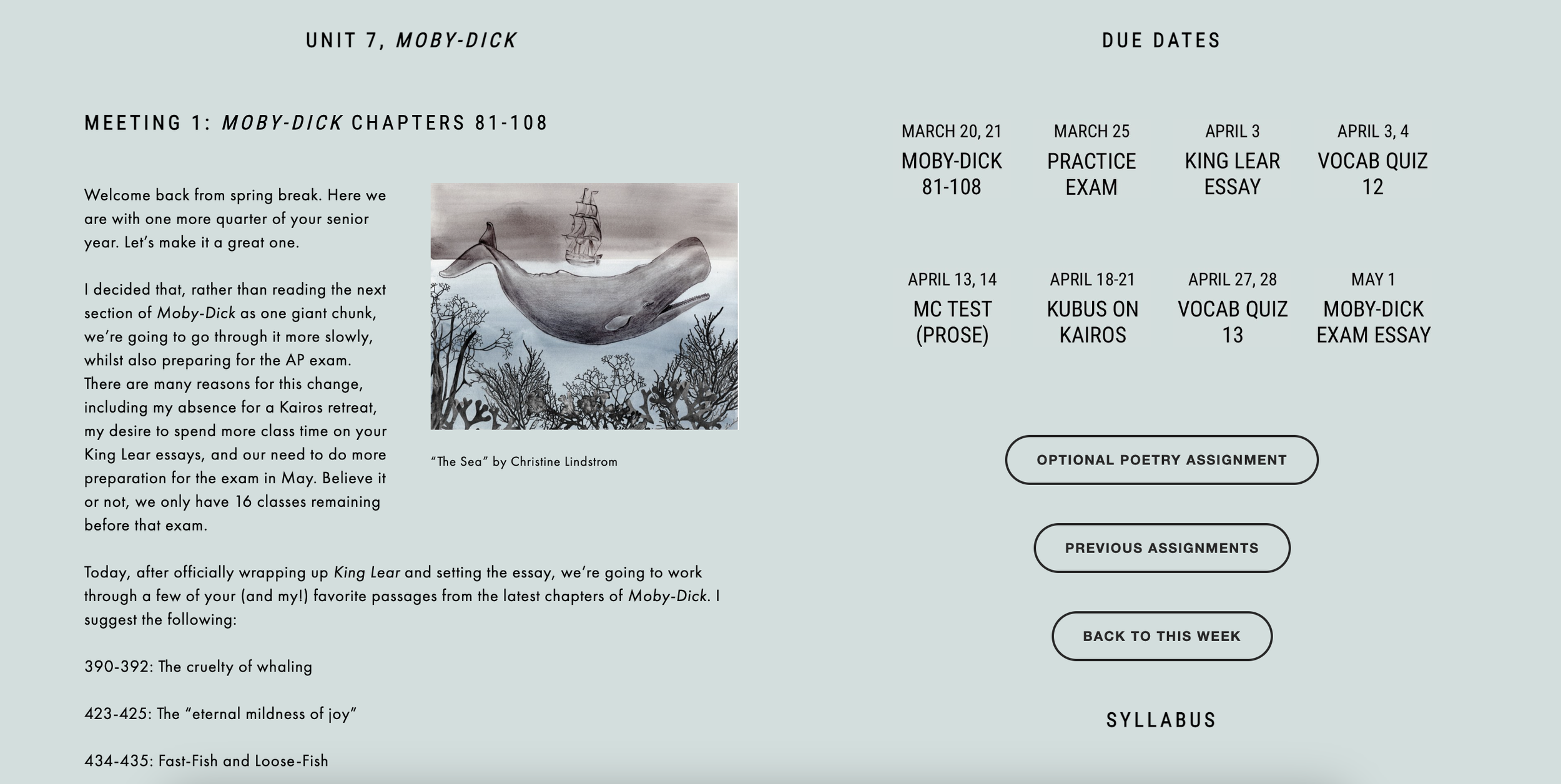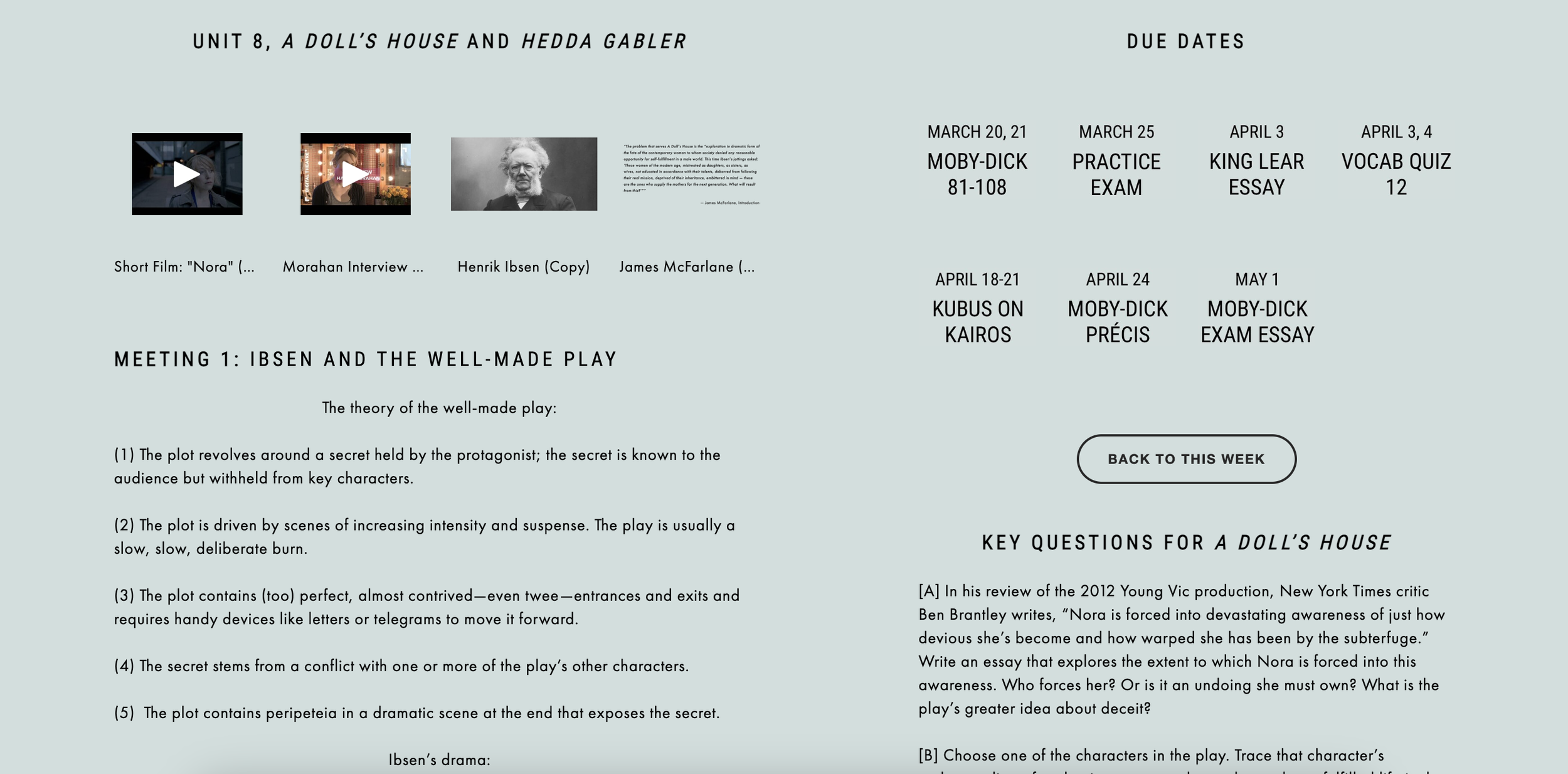unit 6, shakespeare’s othello
meeting 1: the beginning of othello
Welcome back. What’s the password?
Page 3. 2 outstanding readers. Let’s jump right in.
A good scene revolves around conflict and tension: What’s the immediate conflict, and what other conflicts evolve throughout the scene? Who has the power? How do you know?
In 1.1, Iago reveals to Roderigo his feelings about his general, Othello. Why does he feel this way? What are your first impressions of Iago?
What’s Iago’s plan to get back at Othello?
How does Brabantio assume Othello won his daughter?
We’ll watch and converse about two versions of 1.1.
Homework: Dive into a very short scene 2 on your own. What are your first impressions of Othello? How does he respond to the accusations of Brabantio? Is the Othello we see the same one as was described in 1.1? What is his attitude toward Desdemona?
I suggest the following the method for working through a scene of Shakespeare: Read-Watch-Read. Give the scene your best effort first by reading it through. How much could you glean? Then log in to the 2013 production above and watch what you just read. It begins at 7:10 and ends at 11:21. Finally, go back to the text and read it again. Now, the scene should be much clearer compared to the first time you watched.
meeting 2: the origins of drama; mimesis; 1.2-1.3
Today we’ll begin with the next vocabulary lost and sentence pattern. Your quiz will be January 23 or 24.
A more thorough introduction to drama and this play
Let’s go through 1.2, which I ask you to read and watch before class and during which we meet the title character. If all you need to know about Othello and all you need to know about Iago and all you need to know about Cassio can be found in this scene, then what’s all you need to know about Othello, Iago, Cassio? Explain.
In 1.3, we will skip over (though I will explain) the first 47 lines of the scene, so we have time to get to the bulk of the scene.
What do we learn about Othello and Desdemona in Othello's long defense of himself? What do we learn about Desdemona from her father during that defense? Why did Othello marry Desdemona? Why did Desdemona marry Othello?
Homework: R-W-R to the end of Act 1 before our next class. Know it well, especially the dialogue between Roderigo and Iago.
meeting 3: quiz 1; soliloquy; 1.3-2.1
Rory Kinnear as Iago
Today we’ll begin by reviewing what it was I had you read for today: What did Iago reveal in his soliloquy at the end of 1.3? What is the convention of the soliloquy used for?
Soliloquy literally means talking alone, and it has been used as a form since the Greeks, though popularized by Shakespeare and his contemporary playwrights. In the theater, no thinking can be made directly available to the audience unless it is brought to speech, so it was necessary to propose a convention: the character would speak aloud, and the audience would understand that what they were to imagine they were hearing was what the character was saying to himself, or what he would say if he were to give voice to his thought.
I’ve already mentioned in class that real drama occurs when characters keep things from each other. The ONLY time, in fact, that an audience should accept that what characters are saying is absolutely true is when a character is in soliloquy. In all other instances there’s the possibility of deceit. So, it’s the responsibility of the playwright in a soliloquy to communicate what is absolutely true. Iago, for instance, is completely forthcoming about not knowing exactly what his plan is and what he really thinks about Othello and Roderigo. [NOTICE: Iago switches from prose to verse when Roderigo exits. Shakespeare uses this linguistic change to signal to his actors Iago was being deceptive and is now wholly forthcoming.]
2.1: Why the setting change? What is the function of the scene prior to Othello’s arrival? What do we learn about Desdemona?
What is Iago’s next plan at the end of 2.1?
Homework: Set a timer for 14 minutes and complete the MCQ set on the final section of 1.3.
meeting 4: shakespeare; 2.1-2.3
Let’s check your answers on the MCQ set.
Who was Shakespeare, and what has Shakespeare turned into?
Let’s step back and summarize what we’ve learned about each of the following so far: Othello, Iago, Desdemona, Roderigo, Cassio.
We'll look at Iago's second soliloquy carefully. What new reasons does Iago give for hating Othello? What emotion seems to be governing Iago's thoughts and actions? How is Cassio involved in Iago's feelings? Do you think these (and the reasons given in Act 1) are the real reasons for Iago's plotting against Othello? Why or why not?
Homework: R-W-R to the end of Act 2, paying particular attention to Iago’s third soliloquy on page 87: How does Iago continue to rationalize his actions?
meeting 5: prose/verse; 2.3
Let’s step back and summarize what we’ve learned about each of the following so far: Othello, Iago, Desdemona, Roderigo, Cassio.
Then we’ll discuss the circumstances under which Shakespeare gives his characters verse and prose to speak. As you continue to read, pay attention to shifts between prose and verse as they often provide insight into the dynamics in the scene.
How does Othello deal with the fighting? How does what Iago says get Cassio fired?
How does Iago tell Cassio to regain Othello's favor?
Homework: Prepare for our next vocabulary quiz.
meeting 6: vocabulary quiz; 3.1-3.3.92
After the quiz, we’ll pick up 3.1 at line 28 and read through 3.2, into 3.3. This is the beginning of the most carefully crafted scene I know. My favorite, in fact. What’s so important about it? Just look at the emotional distance traveled by Othello:
FROM “Excellent wretch! Perdition catch my soul / But I do love thee! And when I love thee not, Chaos is come again.” (3.3.90-2) TO “Damn her, lewd minx! O, damn her! Damn her! / Come, go with me apart; I will withdraw / To furnish me with some swift means of death / For the fair devil” (3.3.476-9).
He moves from claiming that the only way he couldn’t love Desdemona is if the world reverted back to the time before God created order. A virtual impossibility! And yet look what happens: By the end of the scene he’s sentencing her to hell after a speedy death by his own hand. It had to happen somehow. But how?
Homework: (1) Read Maria Konnikova’s “Born to be Conned”.
(2) R-W-R to 3.3.92, the final moment of joy in Othello’s life.
meeting 7: machiavelli, il principe; 3.3
Sit today with your CHAVRUSA.
“Everyone sees what you appear to be, few experience what you really are.”
“If an injury has to be done to a man it should be so severe that his vengeance need not be feared.”
“The lion cannot protect himself from traps, and the fox cannot defend himself from wolves. One must therefore be a fox to recognize traps, and a lion to frighten wolves.”
“The first method for estimating the intelligence of a ruler is to look at the men he has around him.”
“There is no other way to guard yourself against flattery than by making men understand that telling you the truth will not offend you.”
“Never attempt to win by force what can be won by deception.”
“It is much safer to be feared than loved because ... love is preserved by the link of obligation which, owing to the baseness of men, is broken at every opportunity for their advantage; but fear preserves you by a dread of punishment which never fails.”
Pick a quote from “The Prince”, above, and a character from Othello who might respond to that quote. How might that character respond?
What are the various movements in Iago’s manipulation of Othello?
Homework: Return to 3.3 and re-read the entire scene on your own, studying in greater detail the movements in the scene and Iago’s manipulative tactics. If we did not finish the scene in your class, please make sure you do so on your own.
meeting 8: 3.3-3.4
Sit today with your CHAVRUSA.
You’ll need access to this doc today—I’ll have a hard copy for you in class.
(1) Read each of these key speeches in 3.3.
(2) Identify the speaker.
(3) Follow the thought; listen to the sounds.
(4) Name and elucidate the concrete elements of the language in action, the characteristics of the speech, the key stylistic, rhetorical, or poetic technique the character puts to work. Fully explain the effect of the technique.
In the second half of class, we’ll read and watch together 3.4. What is the function of our new character Bianca?
Homework:
Lots to be getting on with here, but that’s because we’ve an asynchronous order in between.
(1) If we did not finish in class, R-W-R to the end of Act 3 There will be a quiz on Acts 2 and 3 during your class on January 31/February 1.
(2) R-W-R 4.1, pages 145-161. This is a scene filled with action. Notice how it begins. What does it have in common with earlier scenes? What is Iago doing to Othello in the first 45 lines? What does he hope to gain from Othello he does not already have? This is a key question in understanding Iago’s motivations moving forward.
(3) Prepare for the next vocabulary and sentence composition quiz however you see fit, but you might find taking my quiz from last year helpful. I’ll give you a copy in class.
(4) Begin work on your Othello speech analysis.
meeting 9: 4.1-4.2
Othello Quiz 2 (Acts 2 and 3)
What words in Othello carry more meaning than at first glance?
HONEST | INDEED | THINK | SATISFIED | PROOF | DOUBT
4.1:This is a scene filled with action. Notice how it begins. What does it have in common with earlier scenes? What is Iago doing to Othello in the first 45 lines? What does he hope to gain from Othello he does not already have? This is a key question in understanding Iago’s motivations moving forward.
Homework: Prepare for the vocabulary and sentence composition quiz.
meeting 10: 4.2-4.3
Vocabulary and Sentence Composition Quiz 10
4.2: Othello confronts his wife. This is the point where Iago’s plot is most vulnerable. Othello may say something about the handkerchief to Emilia or he might tell his wife about Iago’s dream. What has Iago done to make sure all bases are covered?
Homework:
(1) Finish reading and watching Act 4.
(2) Complete your passage analysis.
(3) If you’re reading Beloved this semester, please remember our next meeting is Monday during community time.
MEETING 11: 4.2-5.1
Shakespeare’s Othello ends with two scenes of murder in stark contrast to one another: The first takes place in a dark street with swords; the second, in a bedroom with a pillow. 5.1 begins with Iago at the height of his manipulative power, trying to pull off a difficult double murder and solve the crime himself.
At this point, Iago controls the perceptions of 7 characters. Who are they?
A total of twenty scenes throughout all of Shakespeare’s plays begin with a line I’ve dubbed Shakespeare’s favorite question: “Who’s there?”. Hamlet begins with it; Othello ends with three instances of it; Macbeth’s Porter asks it three times in one speech. In forty plays, it appears fifty times. And while you might say—‘Well, of course, Mr. Kubus. “Who’s there?” is a common question and a practical one in a staged drama. Why wouldn’t it appear that often?’—I’d like to explore both the dramatic and thematic functions of the question in any given play, in this play, and in this scene.
Homework: R-W-R 5.2.1-90, ending with Shakespeare’s favorite question: “Who’s there?”
MEETING 12: 5.2, scene the last
The final scene of Shakespeare’s Othello is one of the most powerful he ever wrote. How does it contrast to the previous scene of murder? Why pair these scenes together?
Does Othello move from tragic despair to tragic nobility by the end of the play? Your answer to that question will determine whether or not Iago wins. We’ll use this handout to guide our discussion of the play’s final scene.
What AC Bradley thinks: “Even when, at the sight of her apparent obduracy, and at the hearing of words which by a crowning fatality can only reconvince him of her guilt, these feelings give way to others, it is to righteous indignation they give way, not to rage; and, terribly painful as this scene is, there is almost nothing here to diminish the admiration and love which heighten pity. And pity itself vanishes, and love and admiration alone remain, in the majestic dignity and sovereign ascendancy of the close. Chaos has come and gone; and the Othello of the Council-chamber and the quay of Cyprus has returned, or a greater and nobler Othello still. As he speaks those final words in which all the glory and agony of his life--long ago in India and Arabia and Aleppo, and afterwards in Venice, and now in Cyprus--seem to pass before us, like the pictures that flash before the eyes of a drowning man, a triumphant scorn for the fetters of the flesh and the littleness of all the lives that must survive him sweeps our grief away, and when he dies upon a kiss the most painful of all tragedies leaves us for the moment free from pain, and exulting in the power of 'love and man's unconquerable mind.'“
due DATES
CURRENT TEXTs TO HAVE DAILY
upcoming dates for reading groups
syllabus
cyclical vocabulary and sentence composition assignment
writing assignments
2022-2023 UNITS
war and peace central
It seems even Tolstoy didn’t quite know what War and Peace is: “It is not a novel,” he said, “still less an epic poem, still less a historical chronicle. War and Peace is what the author wanted and was able to express, in the form in which it is expressed.” And yet, it’s the first title we think of when we think of some of the greatest or most famous novels ever written. Whatever War and Peace is, it’s innovative: it plays with multiple languages, moves from battlefields to palaces to country estates, combines historical figures like Napoleon and Kutuzov with fictional characters like Bolkonsky and Rostov, folds in bloody battles to scenes of great personal strife and triumph, and changes narrators at will. That’s innovation. Whatever War and Peace is, it’s human: Tolstoy writes no archetypes, but people; no heroes, but soldiers; no villains, but sinners; no pillars of grace, but kind-hearted, flawed characters. That’s human. And whatever War and Peace is, it’s big: With almost 600—yes, 600—named characters, more than 1300 pages, multiple shifts in narrative voice, oscillations between scenes of aristocratic drama and the history of the Napoleonic Wars and some of Tolstoy’s personal philosophy, it’s no wonder Henry James famously called War and Peace “a big, loose, baggy monster.”
Once a month, a small group of us will have a meeting to discuss the next section of the novel, spending a few consecutive days after school with conversation, food, and drink. I hope it’ll be something you really enjoy despite the obstacles of the novel. But don’t let those obstacles prevent you from working through it. Look, I get it: the names are hard, and like I said, there are a lot of them. And look, I get it: Looking at the footnotes to translate the French is annoying. And look, I get it: there are some parts that are just plain dull. It’s okay. Sometimes long-form fiction will be like that. But you’ll do your work, anyway, like the great student and person you are. There are many reasons to set this book down and move on with your life, but there are more reasons—some you may not understand for a few years—to continue working your way through. It’s a work of art filled with beautiful characters, intricately woven threads of plot, thrilling scenes, compelling relationships, people to root for and against. The natural barriers of the novel are nothing compared to the reward on the other side. You’ll be just fine—better than fine, really. And you’re reading in a community of like-minded readers with great opinions to encourage you through it.








